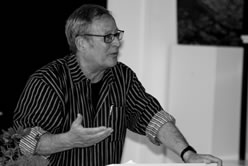|
Very often as writers, we bog down in the rather natural desire to make sense. We write linearly and with reasoned, measured actions. But life and least of all human psychology, the human soul, the human heart, are not linear, measured or reasonable. So how to get some of the vibrant madness and illogical logic of life, of reality, into our writing?
Working in Paris in the late 1950s, Brion Gysin and William S. Burroughs developed the so-called "cut-up" technique to try to get deeper into the unreasonable heart of a material and to free themselves of the authoritarian demand of making sense.
For those who may not be familiar with this technique, here's how it works: You take one or more texts—either of your own or someone else's or both, even documents can be used, ad copy, newspapers, anything; you take a pair of scissors and cut the page or pages once vertically and once horizontally so you have four rectangles of paper (or 8 or 12 or 16 or…, according to how many pages you've stacked together and cut. Now shuffle the rectangles so that scraps of different sentences come together. Don't feel compelled to be slavish about fitting the physical pieces of paper evenly together, but move them, up and down until pleasingly mad patterns of words begin to appear—or perhaps even not so mad, perhaps making some unorthodox sense, achieving the logic of illogic, the sense of nonsense. Work quickly, don't think but use your intuition to choose the combinations, follow your gut feeling, and feel free to select the best of the sentences and draw them together from here and there as you please, as you might collect shells on the beach, guided by your eye rather than your mind, guided by the irrational beauty or striking shape or glitter or whatever, by a logic other than the linear.
Out of all this select enough material to fill a half to a full page, not more (for the purposes of this exercise)—tweak and sculpt it a bit if you like, introduce other elements if you like, a word or a phrase that has been jangling around in your head all day, or a couple of words that randomly catch your eye from a newspaper headline, from an ad on back of The New Yorker, a phrase from a song that happens to be playing on the radio (random selection—or at least seemingly random selection—is important to this process), whatever, squeeze them in, cut, reshape, dropping words, co-opting others, but always working with intuition, never with the conscious controlling manipulating part of your mind. The objective is liberation from the flat pseudo-sense of surface to a deeper sensibility, forged of its own ruleless insistence.
Later, when you turn on your upper mind again and look at what you have, you might be surprised how it bridges and unites the two poles of your existence—or however many poles there are! And it might also go on to inform the process by which you write (remembering what Samuel Beckett said about that: "It all happens between the hand and the page.")
As an example, I tried this recently with some poems I very much like—Matthew Arnold's "Dover Beach," Allen Ginsberg's "Howl," Francis Thompson's "Hounds of Heaven," Bob Dylan's "Subterranean Homesick Blues," together with the Pledge of Allegiance to the American flag as well as a patriotic essay on the same website as the Pledge, a page from a biography I was reading of Søren Kierkegaard (who actually conceived of something very similar to the cut-up technique 120 years before Gysin and Burroughs did—Kierkegaard called it "The Rotation Method.")
Although I didn't think about it in advance—my choice of materials was random—only afterwards did I realize that I was being guided by a subconscious sense of selection, for the texts I chose are: (1) about the loss of faith ("Dover Beach"), (2) about the inevitability of God ("Hounds of Heaven"), (3) about the insanity produced by an overly rational society ("Howl"), (4) the subjugation of reason to a political pledge (Pledge of Allegiance) and (5) biographical notes about a man who challenged the supposed rationality of the mind. Only after I had completed the experiment, did I realize how thematically interrelated these texts were (perhaps because there is a pattern to the things that attract us).
I cut these texts up as described above and shuffled them, and following is the result:
HOWLDOVER
The sea turning through Laredo
its melancholy nightmares
and ignorant lightning in the mind
doom hound on the juke
I fled
I fled
I hid
I pledge allegiance to the naked wail
still within the little children's eyes
who dreamt mother
doe-eyed heaven shrew
expelled from academic skulls.
My grandfather's the toughest bone
who broke down crying at the sheets remorse
face full of black flag
glory over her face
ebb and flow
howl'd over moon straits
grinding teeth for bread
white defenders
roar withdraw, secret hero
of horror dreams.
I had a vision of nothing
shelter me, American trench coat
across boundaries
blank
blank
blank
the tide, the sea
Listen!
Incidentally, the three lines "blank/blank/blank" came about because three of my cut rectangles in a row had nothing on them, and my mind said "blank blank blank" as I turned them over, and the repetition of the word seemed to have a power that inserted itself into the flow of it all.
This game is one that I find useful when I am becoming so judgmental of the words I produce in trying to write that I block, when nothing I put down on the page is good enough. Sometimes this can put us back into touch with the place within where the words come from.
|


